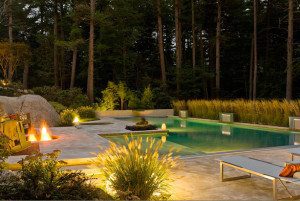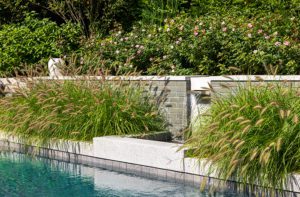A Designer’s Summer Home in Connecticut
July 31, 2019
Text by Debra Judge Silber Photography by Michael Partenio Produced by Stacy Kunstel
Designing your own home—if you’re a designer—should be the easiest thing in the world. Not so, says Hannah Childs, who discovered the challenge of being her own client when she worked on her family’s summer home on the Connecticut coast. “When you’re a designer, you know there are countless choices,” she says. “So, making a choice and sticking with it is very challenging. What I thought I wanted was not at all close to what I chose when it all came to fruition.”
It’s a surprising admission considering how the finished house, done in collaboration with architect John Allee, appears so self-assured and secure in what it was meant to be: an honest and inviting family retreat that mingles comfortably with its cedar-shingled neighbors while asserting an unmistakably contemporary personality.
Childs and her husband had purchased the property in the Lyme enclave of Old Black Point shortly after they married, but it was only recently that they decided to improve upon the house and the dilapidated, motel-like guest quarters that stood on the property. With one street separating the site from Long Island Sound, the first item on the designer’s wish list was a south-facing, second-story master bedroom to take in the view. Second was lots of windows and lofty spaces. “I wanted it to be light-filled, really open,” she says, which meant it would need to depart from the closed-in Shingle-style homes around it. Childs turned to Allee, with whom she’d just completed a project in the area. “He’s got a much more modern aesthetic than I do,” she says. “I felt I really needed his guidance to push the limit a bit for me.”
To help make the roughly 7,000-square-foot house comfortable among its peers, Allee suggested it take the form of several connected structures. From the street it appears as a single, modern-style shingle cottage with two forward-facing gables. Around back, though, it resembles a compound. A large screened pavilion with breezeways on each end links the west wing of the front house to the long side of a guest house, creating a courtyard-like area. It’s here that the home’s primary entry is located, tucked casually inside a breezeway.
Situating the “front” door in this unassuming location was driven by practicalities: close setbacks on either side, the need to keep the existing driveway where it was, and the placement of a septic system under the front lawn. But ultimately, the decision matches the intentions that drove the home’s design. To Allee, the meandering route to the house reflects the low-key lifestyle and informality the family sought. “It’s nice to have a progression as you enter any property, but with this one especially it made more sense to come in along the side,” he says, describing the driveway as it curves past a spreading locust tree and ends in the courtyard.
The dynamism Allee references comes alive in the timber-frame structure of the screened pavilion with its methodically pegged joints and trusses of Alaskan yellow cedar. “That space is phenomenal,” Childs says of the pavilion, which shelters a Ping-Pong table and dining area and provides a mingling spot between the main and guest houses. The timber framing, not originally part of the plan, evolved naturally as a bridge between the home’s traditional and contemporary sensibilities, Allee says. Elsewhere he employed post-and-beam, structural panels, and conventional framing to create spaces that are by turns lofty or solid, traditional or modern. Other elements that bridge the timeline include the roof—metal on the pavilion and guest house and cedar-shingles on the street-facing side—along with horizontal window grids.
The connection to outdoors is enhanced elsewhere with multiple sliding doors and, on the second floor, a sheltered deck off the master bedroom that grants Childs the water view that topped her initial wish list. It’s out there, she says, that she likes to begin and end each day.
Her favorite spot, however, is the great room, a loft-like space with a center partition that separates a comfy TV room and dining area from an equally cozy reading room. Childs is drawn to the scale of the open ceiling, the light that pours in from both sides, and its multiple functions. “I love that it’s all one space. I can sit on one side and my kids can be watching a movie on the other side. We’re all together, but we’re all doing our own thing.”
With her own three teenagers—and their friends—frequenting the house, Childs wanted to keep its spaces and furnishings simple. “I wanted it to be minimalist, clean, and easy,” she says. “Inviting but not fussy, for kids and adults alike.”
Spontaneous gatherings can assemble in the great room, the pavilion, or, of course, in the kitchen, where sliding doors allow the party to migrate between patios on either side. With an adjacent pantry handling storage, the kitchen itself is simple, with wood shelves against white subway tile and natural wood beams that suggest an open ceiling. The white Caesarstone countertops are forty inches tall to accommodate the family of taller-than-average cooks.
Childs surprised herself by choosing a striking Prussian blue from Fine Paints of Europe for the cabinetry, and even more by returning to that color again and again as she furnished the house. “I’ve never been a blue person,” she says. But she also allowed a bright orange bench in the entryway and a set of colorful prints that splash pink, orange, and green on their way up the stairs. With windows framing landscapes on most exterior walls, there’s little room—or need—for additional art. An exception is the broad side of the partition that faces the reading room. For this space, Childs pulled out a matched set of four large seascape pastels by Chester artist Deborah Quinn-Munson that she’d purchased more than a decade ago. Unable to decide on one, she’d bought all four. They fit the wall as if it were designed just for them.
Project Team
Architecture: John Allee, Allee Architecture + Design
Interior design: Hannah Childs, Hannah Childs Interior Design
Builder: United Construction + Engineering
Share
![NEH-Logo_Black[1] NEH-Logo_Black[1]](https://b2915716.smushcdn.com/2915716/wp-content/uploads/2022/08/NEH-Logo_Black1-300x162.jpg?lossy=1&strip=1&webp=1)


















You must be logged in to post a comment.